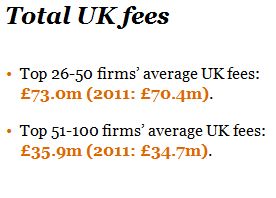Are there too many lawyers? And are law firms ‘cheating’ on the figures to kid themselves?
10 January 2013 By Northern Lights

Guest blog by Peter Smart, Yorkshire head of Managing Partners’ Forum
David Thurkettle of PwC gave his usual thought provoking analysis of trends in law firms from PwC’s Law firms’ survey 2012. I had introduced his session, saying that my own view of the legal market is that it is still very tough, quite patchy and performance is generally flat. David said the survey pretty much said the same thing.
The presentation covered the UK’s top 100 Law Firms as ranked by The Lawyer magazine. David said the themes that came out in the recently published Law Society LMS Bechmarking Survey 2012, which typically covers smaller firms of up to 20 partners, were pretty similar.
Here are the lessons that law firms need to draw from these compelling findings
1. The legal market has shrunk and continues to shrink
The overall legal market is declining. While fee billings may suggest a slight growth, David said if you allow for inflation, this is not a growth market. But David questioned if law firms have really adapted to the new economy.
 2. Are law firms massaging the figures to kid themselves?
2. Are law firms massaging the figures to kid themselves?
The trends of UK fees per full equity partner suggest that profits are on the rise again. David said that for the Magic Circle of law firms, this will be true – they are in a league of their own. But for the remaining law firms, profitability has been achieved by limiting or reducing the number of equity partners.
There was a clear message to make sure partners are not kidding themselves about their figures. David felt the best picture comes from analysing profit per fee earner, taking the whole firm into account.
3. Concentrate on non-billable hours
Looking at the figures below of billable hours, these are way down for all fee-earners. With a typical fee earner spending 1800 hours a year in the office, but registering only 1200 chargeable hours, David’s recommendation is to ask yourself what your fee-earners are doing with the other 600 or so unbilled hours. If they are investing for the future – training, marketing, new business development – that is great; but are they?
And there was a clear warning. Most firms have a lot of spare capacity in them. If growth returns, don’t start recruiting, but look to maximise the returns from existing fee earners.
4. Ask the question – what will you pay and when?
David highlighted the increase in average lock up to 131 and 138 days. Ideally this should be 120 days.
He said debtor days were not a major issue – so once the work is billed it is getting paid. The issue is in getting the work invoiced. Nodding heads around the room suggest this is still a big problem. We need to talk to the clients upfront, agree fees and agree payment terms – and then follow through.
5. If you are already in the s..t, a merger will just make it a bigger heap of problems
There is still a lot of talk of mergers, mostly seen to reduce costs. David’s point was, if you are a business in trouble, merging with another law firm – particularly if they are also struggling – will just produce a bigger heap. Merger does not sort poor billing and profitability.
6. More efficiencies unlikely to produce much return
Firms have relentlessly tackled efficiencies and cut costs over the last four years – but this has produced less than 4% in improvements.
There was a clear message from this research. The legal market has an over-supply of lawyers, we can’t see significant growth changing this any time soon – and law firms still need to tackle old-fashioned business models that are returning declining profit for partners.
Are firms biding their time, thinking an upturn must come some time soon – or are they actually in better shape than these figures might suggest?


